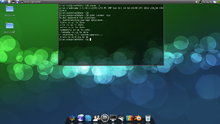GNU
[6][7][8] The use of the completed GNU tools led to the family of operating systems popularly known as Linux.
Richard Stallman, the founder of the project, views GNU as a "technical means to a social end".
[4]: 45:30 Development of the GNU software was initiated by Richard Stallman while he worked at MIT Artificial Intelligence Laboratory.
[4]: 40:52 [18] It was thus decided that the development would be started using C and Lisp as system programming languages,[19] and that GNU would be compatible with Unix.
[21] With the exception of the aforementioned third-party components, most of GNU has been written by volunteers; some in their spare time, some paid by companies,[22] educational institutions, and other non-profit organizations.
[29][better source needed] Many GNU programs have been ported to other operating systems, including proprietary platforms such as Microsoft Windows[30] and macOS.
In modern terminology used by software developers, the collection of these functions is usually referred to as a kernel, while an 'operating system' is expected to have a more extensive set of programs.
Due to the two different definitions of the term 'operating system', there is an ongoing debate concerning the naming of distributions of GNU packages with a non-GNU kernel.
[6][35][36][37] With the April 30, 2015 release of the Debian GNU/Hurd 2015 distro,[38][39] GNU now provides all required components to assemble an operating system that users can install and use on a computer.
[40][41][42] However, the Hurd kernel is not yet considered production-ready but rather a base for further development and non-critical application usage.
[54] The GNU Project recommends that contributors assign the copyright for GNU packages to the Free Software Foundation,[55][56] though the Free Software Foundation considers it acceptable to release small changes to an existing project to the public domain.
Originally drawn by Etienne Suvasa, a bolder and simpler version designed by Aurelio Heckert is now preferred.
It was created by the Free Software Foundation in September 2013 in order to commemorate the 30th anniversary of the GNU Project.




